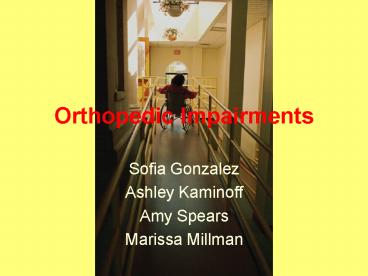Orthopedic Impairments - PowerPoint PPT Presentation
1 / 22
Title:
Orthopedic Impairments
Description:
Orthopedic Impairments Sofia Gonzalez Ashley Kaminoff Amy Spears Marissa Millman * * Definition A severe orthopedic impairment that adversely affects a child s ... – PowerPoint PPT presentation
Number of Views:269
Avg rating:3.0/5.0
Title: Orthopedic Impairments
1
Orthopedic Impairments
- Sofia Gonzalez
- Ashley Kaminoff
- Amy Spears
- Marissa Millman
2
Definition
- A severe orthopedic impairment that adversely
affects a childs developmental or educational
performance
3
What is Orthopedics?
- Orthopedics is the branch of medical science
concerned with disorders or deformities of the
spine and joints (http//wordnetweb.princeton.edu
/perl/webwn?sorthopedics)
4
Prevalence
- The U.S. department of education reports
5,971,495 students receiving special education
services in the 2003-2004 school year. Of that
number, roughly 1.1, or 68,188 students,
received special education services based on a
classification of orthopedic impairments.
5
Causes
- Congenital anomaly (clubfoot, absence of some
member, spina bifida, etc.) - Impairments caused by disease (poliomyelitis,
bone tuberculosis, etc.) - Impairments from other causes (cerebral palsy,
amputations, and fractures or burns that cause
contractures).
- Examples of potential causes of orthopedic
impairment include genetic abnormality, disease,
injury, birth trauma, amputation, burns, or other
causes.
6
Types
- Bone diseases
- Cerebral palsy
- Muscular Dystrophy
- Scoliosis
- Spina Bifida
7
Cerebral Palsy
- Physical impairment that affects movement.
- Four types
- Spastic, athetoid, ataxic, and any combination of
those. - 1 in 400 births (most common in public schools)
8
Cerebral Palsy
- http//www.youtube.com/watch?vlFMLL6A7K0U
9
Muscular Dystrophy
- Muscular dystrophy is a disease that weakens the
muscles. - There are 43 types of muscular dystrophy, most of
which are caused by alterations in specific
genes. - The most common type is Duchenne muscular
dystrophy, and it only affects boys. - It is a genetic disease passed from mother to son
or it can arise in a young boy due to a
spontaneous genetic mutation.
10
(No Transcript)
11
Side effects
- Muscle Weakness
- Paralysis
- Involuntary movements/ abnormal reflexes
- Poor short term memory
- Easily distracted
- Poor attention, organization, sequencing time,
generalization, motivation, coordination.
12
How it is Diagnosed
- 1. Medical or health assessment statement. A
medical statement or a health assessment
statement indicating a diagnosis of an orthopedic
or neuromotor impairment or a description of the
motor impairment - 2. Motor assessment. A standardized motor
assessment, including the areas of fine motor,
gross motor and self-help, when appropriate, by a
specialist knowledgeable about orthopedic or
neuromotor development - 3.Other (A) Any additional assessments necessary
to determine the impact of the suspected
disability (i) On the child's educational
performance for a school-age child or (ii) On
the child's developmental progress for a
preschool child. (Logsdon)
13
Minimum Criteria for a child to be diagnosed
- 1. The child has a motor impairment that results
in deficits in the quality, speed or accuracy of
movement. These deficits must be documented by a
score of two or more standard deviations below
the mean in fine motor skills, gross motor
skills, or self-help skills, or functional
deficits in at least two of these three motor
areas and - 2. The child's condition is permanent or is
expected to last for more than 60 calendar days.
(Logsdon)
14
Educational Considerations
- TESTING
- 1.Allow more time for the student to complete the
activities. - 2. Provide a separate place for the test if
necessary. - 3. Give completely oral tests or completely
written tests, whichever is more appropriate to
the students needs. - 4. Allow students to tape record answers to tests
or type answers, as needed. - 5. Writers should be provided for test-taking if
the student is unable to write (or give oral
tests out of the earshot of other students). - 6. Students may write slowly and need extended
time for tests. - 7. Develop a portfolio of the student's work,
both singly and as part of a cooperating group.
Orally quiz him/her to establish the extent to
which the student contributed to the group-based
accomplishments. (IDEA)
15
Educational Considerations (cont.)
- 1. GROUP WORK
- 2. Include student in open discussions.
- 3. Allow more time for the student to complete
activities. - 4. Use ramps and raised platforms for student's
access. - 5. Lower chalkboard
- (IDEA)
16
Transition in Adulthood
- Jobs available
- Marriage
- Higher education (depending on their condition)
- http//www.youtube.com/watch?v6wLnR7GJakY
17
Technology
- Altered pencils and pens
- Altered keyboards (BAT)
- Powerpads
- Eye-controlled input systems (cyberlink)
- Touch screens
- Track ball
- Foot mice
- Standing table
- Easels
- Adjustable seats and desks
- Portable reading racks
- Speech-controlled input systems (dragon-dictate
and write-away) - Icon-driven communication (dynavox)
18
Spinal Cord Disorders Spina Bifida
- Meet Bryce Lach
19
(No Transcript)
20
(No Transcript)
21
Spina Bifida
- A neural tube birth defect, is the improper
closure of the protective tissue surrounding the
spinal cord. It results in limited neurological
control for organs and muscles controlled by
nerves that originate below the level of the
lesion. Increasing numbers of children have
suffered traumatic head or spinal cord injuries
resulting in permanent disabilities (Smith 320)
22
References
- IDEA. (2007, May). IDEA- Orthopedic Impairment.
Retrieved February 10, 2010, from Special
Education http//www.maryvillecityschools.k12.tn.
us/education/components/scrapbook/default.php?sect
iondetailid14002sc_id1184530038 - IDEA. (2008). Orthopedic Impairments. Retrieved
February 10, 2010, from Oregon Department of
Education http//www.ode.state.or.us/policy/feder
al/idea/specifdisabil/orthodef.aspx - Logsdon, A. (2009, June). Orthopedic Impairments.
Retrieved February 11, 2010, from About.com
http//learningdisabilities.about.com/od/mo/g/Orth
opedic_Impa.htm - Project IDEAL. (2006, November). Orthopedic
Impairments. Retrieved February 11, 2010, from
Project IDEAL http//www.projectidealonline.org/o
rthopedicImpairments.php































